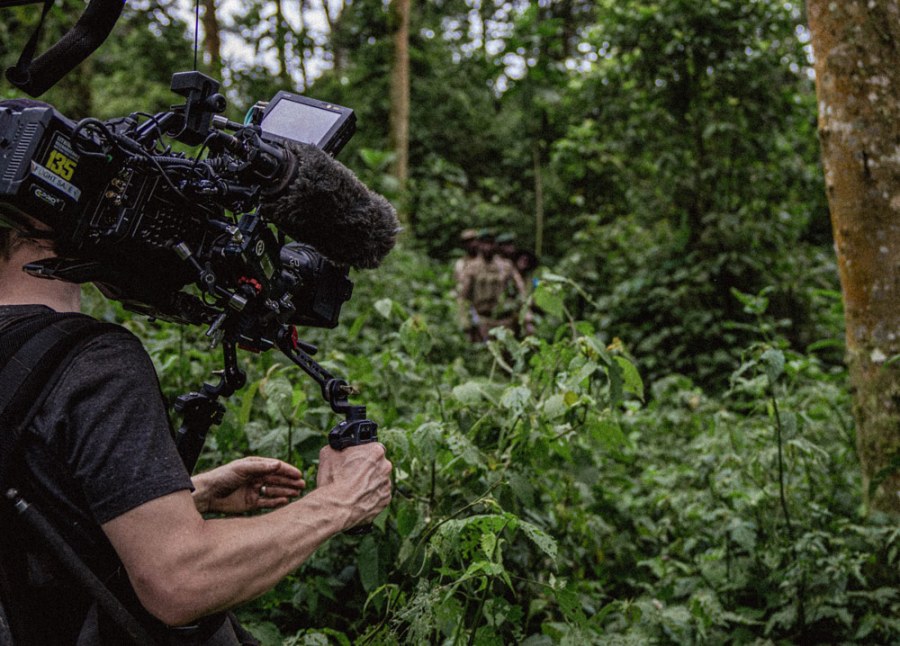Advertising Feature
There are a lot of video-editing programs to choose from, but DaVinci Resolve is one of the best out there – and you only pay for the ‘Studio’ version. The production team of Hearts of Bwindi, a powerful documentary about efforts to save Ugandan gorillas from poachers, explains how DaVinci software was key to the success of the project
As we’ve seen in a previous article, The Hearts of Bwindi documentary is a superlative example of what a small production team from Biscuit Bunker could do with limited budgets. Editor Olly Cooper and the rest of the team made full use of the Blackmagic Design ecosystem and the cloud to work and collaborate across geographical boundaries.
‘As much as possible, the director, Charli Doherty, planned to tell the story of The Hearts of Bwindi with visuals,’ Olly explains. ‘He wanted to include only essential information from the park rangers to let the audience explore their character and passion.’
Hearts of Bwindi: the gear used
‘The rangers don’t track poachers; they work closely with the village communities within the park to protect and safeguard its biodiversity,’ Olly goes on to explain. ‘On location for five days with Charli and producer Tom Neish, our director of production Will Hadley shot mainly on the Blackmagic Design URSA Mini Pro 12K and Pocket Cinema Camera 6K Pro. However, using the Blackmagic RAW codec enabled them to deliver all the footage to me on a 4TB drive.
Charli and Will put so much thought into the shots beforehand and on location that it was visually ‘all there’ on the drive. One of the strongest aspects I found was the framing, especially in the shots we used as the intro. This depicts all the biodiversity of Bwindi, but then racks focus from the forest to show the face of a ranger. Shots like that are almost pillars of the story.’

The characterful faces of the rangers were captured perfectly
Cloud collaboration with DaVinci Resolve Studio
As Olly elaborates, he loves editing in DaVinci Resolve Studio, but for him, the big highlight of this project was the opportunity to use the cloud. ‘For the first half of the post production process, Charli, who was also grading the film, was based between London and Wiltshire, while I live on the south coast.
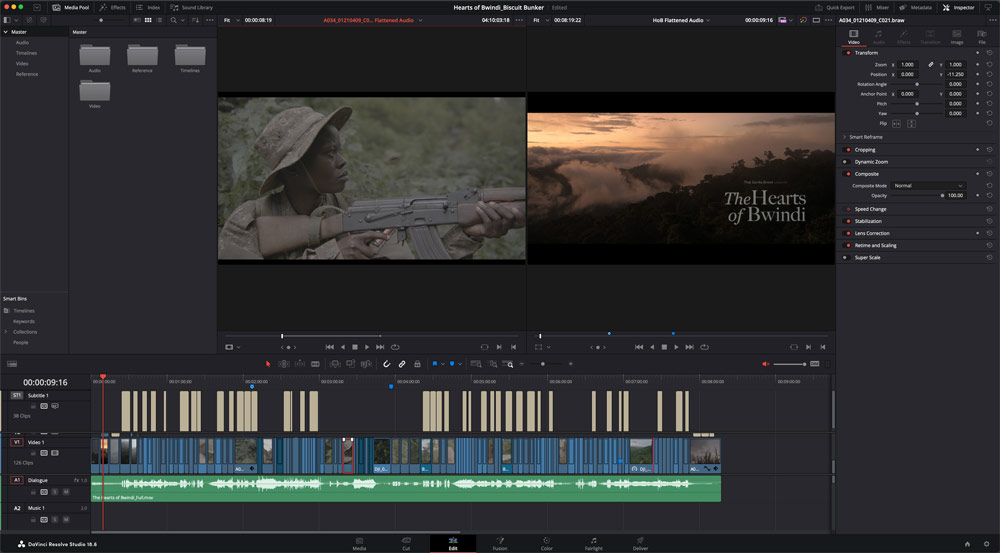
Editing Hearts of Bwindi in DaVinci Resolve Studio
With editing and grading both taking place in DaVinci Resolve Studio, we collaborated using Blackmagic Cloud, a storage system that syncs and shares media files with Dropbox and Google Drive. Charli and I had full resolution files to work on locally, but the project itself lived on the cloud. Everything just syncs up!’
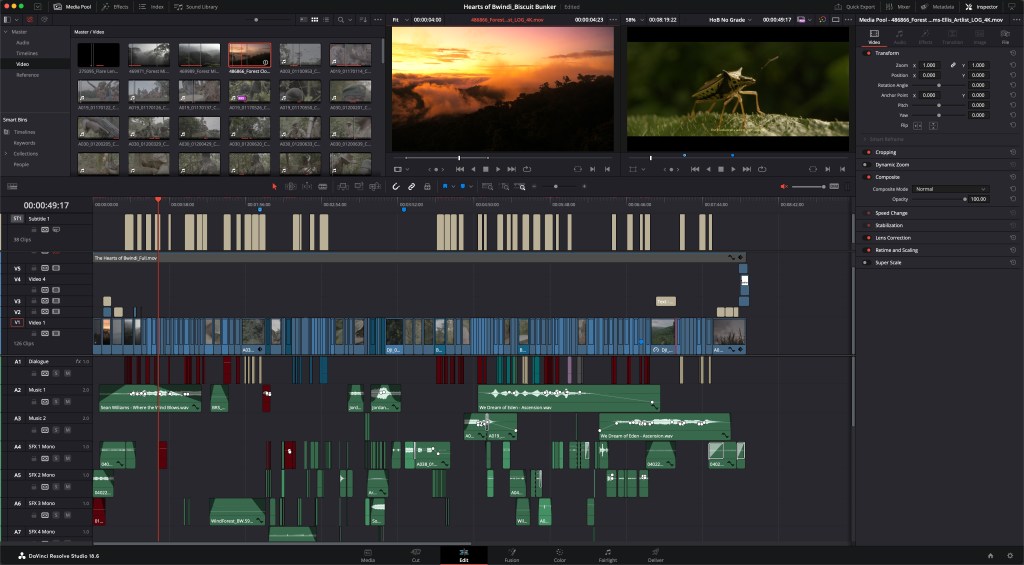
Cloud-based collaboration made the complex editing process more efficient
Olly adds that Charli is also an editor, and is very hands on. ‘We’d each make selects, or raise issues, then jump on a call and start making decisions on the shared project. It’s almost as if we were in the same room. For me, that’s huge. It makes the whole process so much quicker. Halfway through the post, Charli moved to Berlin. However, this didn’t affect the workflow at all.’
Colour grading with DaVinci Resolve Studio
For Hearts of Bwindi, Olly used the DaVinci YRGB colour space for grading the footage. ‘Like the cloud collaboration, it’s just easy. I’m not a colourist so anything that can get me editing quicker without having to faff around with colour-management settings is ideal for me. Likewise, we didn’t have to manage too many different formats and resolutions.’
As well as the URSA 12K and Pocket 6K Pro, a drone was used for some aerial shots above the forest canopy and to show the village, while mini action cameras were placed on the rifles to give a close-up of the soldiers. “DaVinci Resolve Studio recognised the camera and automatically converted the footage so I could to start editing.’
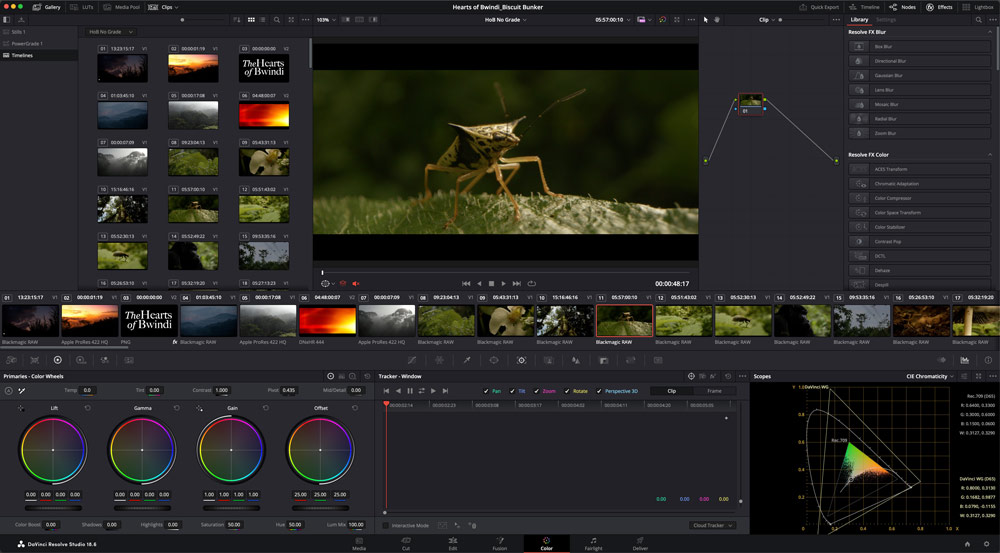
Colour grading with DaVinci Studio 2
There is a range of shades of green everywhere in the film, from the bright green of the village beekeeper’s clothes and the schoolkids’ uniforms to the camouflage of the rangers and the forest itself. ‘Charli, who led the grading, shifted luminance values to add depth and vibrancy to some of the greens and created a nice palette across the film,’ Olly adds.
‘We also found several features in DaVinci Studio Resolve that helped address issues with the footage in post-production. While Will captured some stunning shots, everything was fast paced, and you can never catch it all.
For example, Charli found the Colour Warper tool infinitely helpful when matching between shots and cameras. He also combined the Magic Mask and Power Windows to add a bit of negative fill for contrast. You can apply a stroke to the person in Resolve – it knows it’s a human being – and it creates the mask around them. We also explored the new Relight FX tool in Resolve for a couple of shots to adjust the environmental lighting.’
How DaVinci Resolve Studio helped with sound
Another challenge was the audio, especially when fiming in such a challenging environment. ‘Working on a limited budget, Charli also took on the sound duties, and I was impressed, particularly by the tonal quality of the voices we were recording.
With so much wildlife, the Bwindi national park is an extremely noisy place, so Resolve Studio’s Vocal Isolation plug-in was used on every single bit of audio. It’s a one-slider operation to isolate the vocal, and we could keep the intimate sound of interviews without the noise of the constantly loud crickets. Often if you clean audio up, you can almost destroy it, but we managed to retain a lot of personality in the voices.’
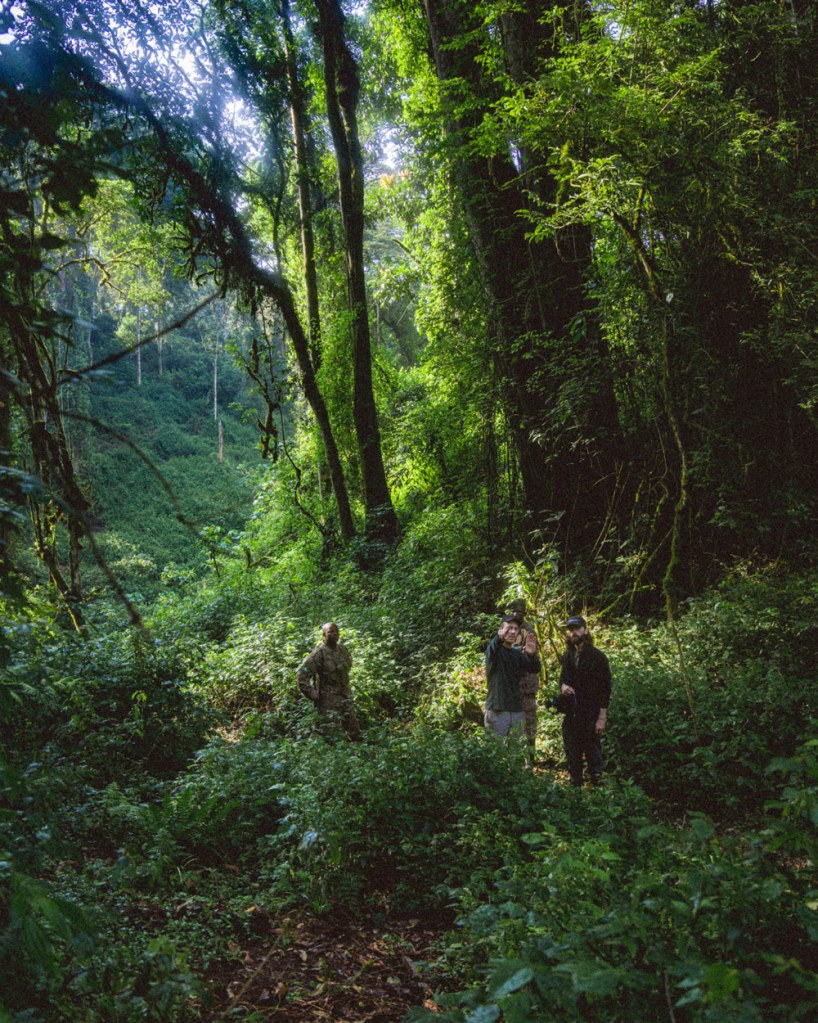
The Bwindi National Park is not a quiet place, and DaVinci Resolve Studio dealt admirably with the audio editing
As Olly explains, DaVinci Resolve also played an important part in preparing the film for distribution. As well as ensuring Hearts of Bwindi looked as good as possible when played on the popular Vimeo platform, the team worked hard to retain the best fidelity and the best colour rendition, with the grain still coming through. ‘We also had to prepare some cut-downs as teasers, but the software can change ratios and automatically reframe for social media.’
So what is Olly’s favourite scene? ‘It has the least amount of dialogue and the most amount of visual storytelling. We hear a bird in the forest canopy, but it’s revealed to be a ranger whistling. I love it for various reasons, not least the message: the main thing the rangers do is preserve nature. I hope people can come away from watching Hearts of Bwindi with lots of questions.’
Further reading
Capturing the brave fight to save gorillas

